Young
Rainfall Analysis
The main rainfall observing site used in this analysis was Wombat (Bureau of Meteorology Station No. 073041), which is 15 km from the centre of Young and has records commencing in 1888. Data from the automatic weather station at Young Airport were used to calculate values for months with missing data at this site (see Appendix 2 for further information).
Note that in the following analyses rainfall totals for individual months or years (where the year is defined as the 12 months from July to June) are compared to the long-term average (or climatology) from 1961-1990. A 30-year period is used to calculate climatological averages to conform with World Meteorological Organisation practice; this takes into account year-to-year variations and less frequent events such as El Niño or La Niña. This particular 30-year period is used internationally as a standard climatological average period.
As shown in the table below, Wombat was drier than average in all four years in the period 2004/05-2007/08. The driest year was 2006/07, when rainfall was 50.9% below the long-term average at 356.3 mm for the year. This is the driest July-June period on record for this site. The wettest year in the last four years was 2007/08, when rainfall was 11.9% below the average.
| Rainfall Statistics | Young (Wombat) | |||
|---|---|---|---|---|
| Annual Total* (mm) | 2004/5 | 2005/6 | 2006/7 | 2007/8 |
| Anomaly (mm) | -162.5 | -121.2 | -368.6 | -86.4 |
| Anomaly (%) | -22.4 | -16.7 | -50.9 | -11.9 |
| Mean (1961-1990) (mm) | 724.9 | |||
*Note: annual totals were calculated for the 12 months July-June.
Monthly Rainfall, 2004-2008
A comparison of monthly rainfall totals with the long-term monthly average rainfall at Wombat (Figure 1) shows that most of the period experienced below-average rainfall, with the exception of the periods May-November 2005 and November 2007 to March 2008. Dry conditions also occurred between December 2004 and May 2005, and from April to June 2008. The prolonged period of below-average rainfall from December 2005 to October 2007 was associated with the 2006/07 El Niño event, while the above average rainfall between November 2007 and March 2008 coincided with the development of a La Niña event.
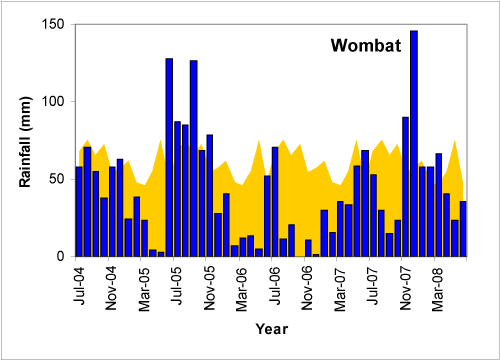 |
Of the 48 months in this period, 37 months (77% of the record) had below-average rainfall at Wombat (Figure 2). The most prolonged dry spell began in December 2005 and extended to October 2007. During this period there were only 5 months of average or near average rainfall. Other significantly dry periods were January to May 2005 and April to June 2008. The driest individual month was October 2006 when no rain was recorded (the long-term average for October is 71.9 mm), while only 1.2 mm was recorded in December 2006 and 2.6 mm in May 2005. Above average rainfall only occurred on two occasions – between June and November 2005, and from November 2007 to March 2008. The wettest month was June 2005 with 128 mm (long term average for June is 47.7 mm), while 126.2 mm was recorded in September 2005 which was the eighth wettest September since 1888.
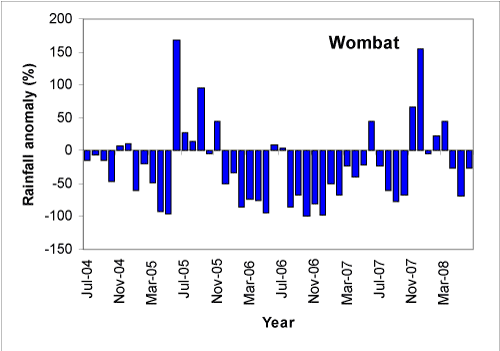 |
The result of the generally dry conditions at Wombat during the period 2004-2008, and particularly in the second half of this period, is reflected in the accumulated rainfall anomaly deficit (Figure 4). Rainfall accumulation was slightly negative during 2004/05, but the deficit increased rapidly during 2006 and 2007 before stabilising in 2008. The rapid drop during 2006/07 reflects the dry conditions associated with the impact of the El Niño event during this period. The accumulated deficit for the four-year period was 732.6 mm (101% of the Jul-Jun average rainfall).
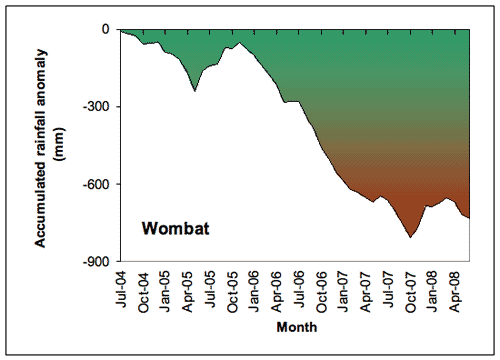 |
The climatological context for rainfall at Wombat
The long-term perspective
The long term rainfall record at Wombat reflects the trends at other locations across south-eastern NSW during this period. Wombat has experienced large fluctuations in annual (July-June) rainfall, including several extended periods of above- or below-average rainfall since records began in 1888. In general, annual rainfall was lower and less variable in the late 19th century, followed by a period of greater variability. Rainfall has been lower than average since about 2000 (Figure 4). This recent dry period is reflected in other parts of the long term record such as the late 19th and early part of the 20th century; the period from the late 1920s to the late 1940s; and the late 1970s. To date the recent dry conditions appear to fall generally within the range of long term rainfall variability in the region, although the last few years contain two of the driest years on record.
- Rainfall in the early 20th century was generally below average (to about 1950). There was a pronounced dry spell from the late 1890’s through to around 1915 with another dry spell from the mid 1920s to the mid 1940s. Since then annual rainfall totals have been more variable.
- Several wetter than normal years around 1950 and 1960 produced a generally wetter period then; the same is true of the mid 1970s.
- A generally drier period around 1980 was followed by slightly above-average rainfall until the early 1990s. Since 1993 conditions have been generally drier than average and particularly since 2000 with 2002/03 and 2006/07 being the driest years on record.
The wettest year (July-June) on record was 1890/91 (1206.8 mm); the driest year was 2006/07 (356.3 mm).
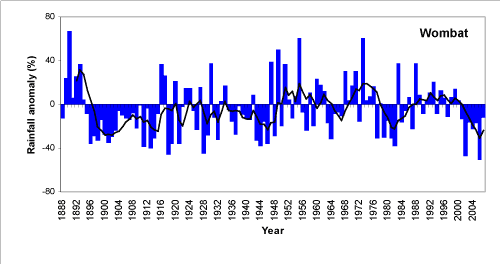 |
Tthe extent of the dry period since 2000 is shown in Figure 5. From 2000 to early 2002 the rainfall accumulation was close to the norm. There was then a rapid increase in the accumulated rainfall deficit during 2002/03, which slowed during 2004/05 but increased again with the dry conditions of 2006/07 before stabilising in 2008. This reflects the impacts of the two El Niño years of 2002/03 and 2006/07. During the eight-year period there were 67 months (70%) of rainfall deficit; the total accumulated deficit is 1252.8 mm (173 % of the average Jul-Jun rainfall).
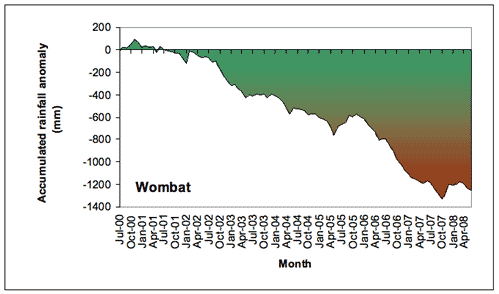 |
About the data
